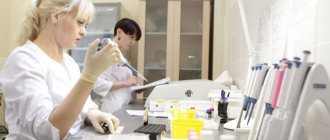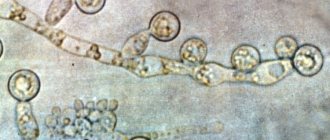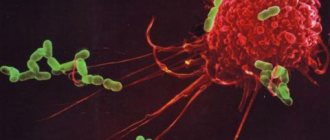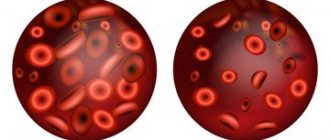What it is
The vagina of a healthy woman is not sterile; it contains a large number of different microorganisms, which are collectively called microflora. Bacilli are in a state of constant competition for habitat on mucous membranes and nutrients.
The most numerous and dominant species is lactobacilli, or Dederlein's bacilli. Bifidobacteria are in second place in number. Both are beneficial bacilli and synthesize peroxide, alcohols, lactic and other acids to provide an acidic vaginal environment. The function of bifidobacteria and lactobacilli also includes the production of lysozyme and some enzymes that inhibit the activity and reproduction of harmful microbes.
INTERESTING! Lysozyme is an antibacterial substance, an enzyme from the category of hydrolases. It destroys bacterial cell walls by hydrolyzing the peptidoglycan of which they are composed. It is found in large quantities in human saliva, due to which it has antibacterial properties.
The concentration of lysozyme is also high in breast milk and is about 400 mg/l - this is much more than in cow's milk. In addition, the level of the substance does not decrease over time, and 6 months after birth it even increases.
If Dederlein bacilli predominate in the smear, then the woman is healthy. In this case, a slight content of leukocytes is allowed, but no more than 10 in the field of view of the laboratory assistant.
In the case of a predominance of small rod flora, we are talking about bacterial vaginosis, or gardnerellosis. Under these general concepts denoting dysbiosis, different indicators may be hidden.
Classification
According to the Hay-Ison scale, based on the results of microscopy of a Gram-stained smear, there are 5 degrees of disturbance of the vaginal microflora:
- 0 – only epithelial cells are present, no bacilli present. Occurs after recent antibiotic therapy;
- 1 (normal) – gram-positive Dederlein rods, or morphotype of lactobacilli, predominate;
- 2 (mixed type) – both lactobacilli and small rods were found in the smear (gardnerella);
- 3 (dysbiosis) – gardnerella in large quantities, lactobacilli are few or not present at all;
- 4 – lactobacilli are absent, the flora is represented by opportunistic, or gram-positive, cocci.
Important: With lactobacillary microflora, a significant criterion is the levels of leukocytes and erythrocytes, or rather, their ratio with beneficial bacteria. Therefore, the diagnosis is made based on the overall picture.
The results of a smear test for microflora are valid for 10 days. Gynecologists advise taking it 1-2 times a year as a preventive measure, so as not to miss the onset of the disease.
If the coccal flora dominates, then there will be a lot of leukocytes in the smear. In this case, we can talk about bacterial vaginosis or an existing sexually transmitted disease (STD).
Zero degree of microflora disturbance means its complete absence, which is typical for women who have taken a course of antibiotics. To restore balance and repopulate the vagina with beneficial bacilli, medications are prescribed and dietary recommendations are given.
Thus, Dederlein bacilli are the main component of the microflora. They maintain a normal level of acidity and block access to infectious agents. Lactobacilli are a kind of filter, including for viable male germ cells. The acidic environment is not suitable for most microbes and weak sperm; if they get into it, they do not survive.
The importance of microflora balance
Many different bacteria live in symbiosis with the human body. When maintaining balance, all together they form a normal microflora. Bacteria live on the mucous membranes of the mouth, intestines and genitals.
All flora in the human body can be divided into:
- normal;
- opportunistic;
- pathogenic.
Normal flora supports the proper functioning of organs. Beneficial microorganisms perform protective functions and contribute to a general increase in immunity. Such flora is necessary for the normal functioning of the body.
Opportunistic microflora does not bring benefit, but in small quantities it does not interfere.
If, under the influence of any negative factors, bacteria and fungi begin to actively multiply, then under the influence of their metabolic products, the normal flora will be suppressed, and the organs will not be able to fully function.
Thus, even simple vaginal dysbiosis without treatment can cause a woman a lot of discomfort and create a favorable environment for the development of infections, causing complications.
Pathogenic bacteria have a sharply negative effect on the condition of the body.
Reduced immunity, imbalance of microflora, failure to comply with personal hygiene rules and a number of other reasons significantly increase the chances of developing an infection, while a healthy body has much greater resistance to the effects of pathogenic microbes.
A flora smear allows women to determine changes in the vaginal microflora. For preventive purposes, it is recommended to carry out analysis at least once a year.
READ How is a gonorrhea smear taken in men and women?
For diagnosis, it is recommended to take a vaginal microflora test when:
- unusual, copious discharge with a sour or fishy odor, gray, yellowish or green in color;
- curdled formations;
- constant itching in the perineal area;
- pain that occurs during urination or sexual intercourse.
Gram-positive and gram-negative
In conclusion to the analysis, you can read the names of gram-positive or gram-negative bacilli. These terms mean that positive particles change color, but negative particles do not. The method of staining microorganisms for research was proposed by the Danish physician Gram in 1884 in order to distinguish bacteria by the biochemical characteristics of their cell walls.
Gram rods in a smear in women should normally be predominantly positive, that is, with a predominance of lactobacilli. Then this is a good sign. However, with age, the number of useful gram-positive rods decreases, and in the menopause they increasingly give way to gram-negative ones.
Methylene blue dye is used for Gram staining. After staining, it is not difficult to establish the type of bacteria and determine the composition of the microflora. This technique is of key importance in the systematization of bacilli and microbiological diagnosis of infectious pathologies.
Large and stable Dederlein rods feed on glycogen grains, which are contained in the epithelial cells of the vagina. As a result of its processing, lactic acid is formed, which inhibits the growth of other microbes. A decrease in the number of lactobacilli indicates the development of dysbiosis and accompanies most infectious diseases of the female urogenital tract.
Coccal and spore-bearing forms of bacteria are also Gram-positive, with the exception of Neisseria, the causative agent of gonorrhea and meningitis. When stained, they become dark blue or blue-black.
Gram-negative organisms are non-spore-bearing bacilli that appear red in color. Among them there are opportunistic and pathogenic species that can cause serious diseases. In addition, gram-negative bacteria are highly resistant to antibiotics, making them difficult to control.
The term “microflora” is gradually being replaced by the concepts of “microbiot” or “microbiome”. It is believed that microorganisms living inside humans have nothing to do with the plant world, and each of them has its own genome.
Polymorphism
The shape of bacteria varies. Some are round or oval - they are called cocci. Others are rod-shaped and belong to the bacillary flora. The third spiral-shaped ones are spirochetes, which are the causative agents of such dangerous infections as typhoid, syphilis and leptospirosis.
However, a number of sticks can take any of the forms - this is polymorphism. They do not have a specific configuration or have a different shape from the main types. Polymorphic rod flora occurs when the balance between beneficial and harmful bacteria is disturbed, that is, when favorable conditions are created.
The acidic environment of the vagina is not suitable for harmful microorganisms, since it contains a lot of lactic acid, synthesized due to the hormone estrogen. 97-98% of the microflora normally consists of lactic acid bacilli, and they coexist quite peacefully with opportunistic particles - cocci, rods.
But under the influence of external and internal factors, when the volume of opportunistic organisms becomes more than 10.3 CFU/ml, an imbalance appears, leading to bacterial damage. And the growth of the coccal flora is accompanied by the multiplication of the polymorphic bacillus.
Important! Predisposing factors that can provoke disturbances in the composition of the microflora can be various diseases, decreased immunity, and poor hygiene.
Bacteria are highly plastic and easily change under the influence of various substances, acids and temperatures. They can increase in size, swell, and take on spherical and thread-like shapes. Such metamorphoses are associated with a violation of the structure of the cell wall or the mechanism for regulating cell division
A polymorphic rod in a smear in women can have a number of other reasons, including:
Klebsiella pneumonia in smear
- damage to the vaginal mucosa;
- prolonged and uncontrolled treatment with antibiotics;
- hormonal changes during menopause, pregnancy, menstrual cycle disruption;
- infectious pathologies;
- promiscuous sex life;
- ignoring barrier methods of contraception;
- treatment with hormonal drugs that weaken the immune system;
- frequent douching without a doctor's prescription.
A large number of sticks in a smear
It all depends on which sticks cover the surface of the vaginal mucosa. As already mentioned, for normal conception and the impossibility of infections in the female body there must be at least 95% lactobacilli . As gynecologists say, a woman’s vagina has the first degree of purity.
As soon as the Dederlein bacillus begins to die, the laboratory assistant looks at the number of pathogenic bacillus. If the smear contains 80% Latobacteria, we can talk about the second degree of purity , at any moment the woman may become irritated and develop thrush.
Expert opinion
Kovaleva Elena Anatolyevna
Doctor-Laboratory Assistant. 14 years of experience in clinical diagnostic services.
Ask a question to an expert
When the number of Dederlein sticks is reduced to 70%, we can talk about the third degree of purity. This is already a clear indicator of the development of pathogenic processes, perhaps there is an initial degree of vaginal dysbiosis, thrush and itching appear.
As soon as the indicator of lactobacilli reaches less than 70%, we are already talking about dangerous conditions.
Even if pregnancy occurs, there will be a high probability of its termination, the woman has obvious dysbacteriosis, and the discharge smells very bad . Externally, the genitals are swollen and there is obvious redness. It is important to immediately begin adequate treatment so that the infection does not spread upward to the appendages.
Purity standards: 4 degrees
| Degree | Composition of the smear | Meaning |
| 1 | Dederlein rods (lactobacillus) - majority; Other bacteria - single; Mucus - insignificant; Leukocytes - up to 10; Epithelial cells - 5-10; Medium - acidic | An ideal, but very rare option, which is almost never found in women of fertile age who are sexually active |
| 2 | Dederlein rods – in the majority; Gram-positive cocci – slightly; Mucus – slightly; Epithelial cells – 5-10; Leukocytes – up to 10; Medium – slightly acidic | Variant of the norm, typical for most healthy women |
| 3 | Gram-negative rod flora and cocci - the majority; There are key cells; Dederlein's rods - single; Mucus - moderate; Leukocytes - >10; Epithelial cells - >10; Medium - neutral | Colpitis (vaginitis) is inflammation of the vaginal mucosa. The causative agent can be chlamydia, staphylococcus, mycoplasma, trichomonas, staphylococcus, hemophilus influenzae, as well as several infections at once |
| 4 | Dederlein's rods - none or single; Opportunistic and pathogenic microorganisms - abundant; Mucus - a lot; Leukocytes - >30; Epithelial cells - a lot; Medium - neutral or alkaline, pH>4.5 | Intense inflammation, which is accompanied by severe symptoms |
Advice on how to properly prepare for a smear test
You should take a smear for microflora no earlier than 3 days after the end of menstruation, since blood cells can distort the result. The ideal time is 10-20 days of the cycle.
For maximum accuracy of indicators, it is recommended to follow several rules:
- two weeks before the test, stop taking antibiotics and antimycotic (antifungal) agents;
- Avoid sex for 2-3 days;
- 2 days in advance, stop using any vaginal forms of medications - suppositories, vaginal tablets, sprays, creams, solutions;
- immediately before the procedure, avoid douching and washing.
Why do they do a smear on the flora?
Such an analysis helps to fully examine the condition of the genital organs and detect the presence of any foreign cultures in them.
It also helps to track:
- risks of developing cancer pathologies;
- level of erythrocytes, leukocytes;
- concentration of lactobacilli;
- the presence of viral and infectious diseases.
Taking a smear is a completely painless and quick procedure. The state of the vaginal microflora may change depending on the influence of certain factors. It is for this reason that women are advised to properly prepare for a smear test.
Preparation consists of following some rules:
- you cannot go to the gynecologist during menstruation or at the end/beginning of the menstrual cycle;
- on the day of delivery, do not take a bath or douche;
- several hours before the test, do not go to the toilet;
- carry out genital hygiene only with products with a neutral pH or without them at all;
- within a few days (preferably a week), stop using tampons, vaginal suppositories, ointments and lubricants.
In some cases, a smear for flora can be taken from the nasopharynx cavity. In this case, the patient should not brush her teeth, rinse her mouth, drink or eat before the test.










